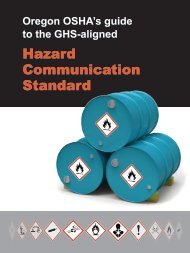Technical Manual - Section 3 (Safety Hazards)
Technical Manual - Section 3 (Safety Hazards)
Technical Manual - Section 3 (Safety Hazards)
Create successful ePaper yourself
Turn your PDF publications into a flip-book with our unique Google optimized e-Paper software.
B. OVERVIEW OF THE PETROLEUM INDUSTRY<br />
BASIC REFINERY PROCESS --<br />
DESCRIPTION AND HISTORY<br />
Petroleum refining has evolved continuously in response to<br />
changing consumer demand for better and different products.<br />
The original requirement was to produce kerosene as a<br />
cheaper and better source of light than whale oil. The<br />
development of the internal combustion engine led to the<br />
production of gasoline and diesel fuels. The evolution of the<br />
airplane created a need first for high-octane aviation gasoline<br />
and then for jet fuel, a sophisticated form of the original<br />
product, kerosene. Present-day refineries produce a variety of<br />
products including many required as feedstocks for the<br />
petrochemical industry.<br />
DISTILLATION PROCESSES<br />
The first refinery, opened in 1861, produced kerosene by<br />
simple atmospheric distillation. Its by-products included tar<br />
and naphtha. It was soon discovered that high- quality<br />
lubricating oils could be produced by distilling petroleum<br />
under vacuum. However, for the next 30 years kerosene was<br />
the product consumers wanted. Two significant events<br />
changed this situation: (1) invention of the electric light<br />
decreased the demand for kerosene, and (2) invention of the<br />
internal combustion engine created a demand for diesel fuel<br />
and gasoline (naphtha).<br />
THERMAL CRACKING PROCESSES<br />
With the advent of mass production and World War I, the<br />
number of gasoline-powered vehicles increased dramatically<br />
and the demand for gasoline grew accordingly. However,<br />
distillation processes produced only a certain amount of<br />
gasoline from crude oil. In 1913, the thermal cracking process<br />
was developed, which subjected heavy fuels to both pressure<br />
and intense heat, physically breaking the large molecules into<br />
smaller ones to produce additional gasoline and distillate<br />
fuels. Visbreaking, another form of thermal cracking, was<br />
developed in the late 1930s to produce more desirable and<br />
valuable products.<br />
CATALYTIC PROCESSES<br />
Higher-compression gasoline engines required higher-octane<br />
gasoline with better antiknock characteristics. The<br />
introduction of catalytic cracking and polymerization<br />
processes in the mid- to late 1930s met the demand by<br />
providing improved gasoline yields and higher octane<br />
numbers.<br />
Alkylation, another catalytic process developed in the early<br />
1940s, produced more high-octane aviation gasoline and<br />
petrochemical feedstocks for explosives and synthetic rubber.<br />
Subsequently, catalytic isomerization was developed to<br />
convert hydrocarbons to produce increased quantities of<br />
alkylation feedstocks. Improved catalysts and process<br />
methods such as hydrocracking and reforming were<br />
developed throughout the 1960s to increase gasoline yields<br />
and improve antiknock characteristics. These catalytic<br />
processes also produced hydrocarbon molecules with a<br />
double bond (alkenes) and formed the basis of the modern<br />
petrochemical industry.<br />
TREATMENT PROCESSES<br />
Throughout the history of refining, various treatment methods<br />
have been used to remove nonhydrocarbons, impurities, and<br />
other constituents that adversely affect the properties of<br />
finished products or reduce the efficiency of the conversion<br />
processes. Treating can involve chemical reaction and/or<br />
physical separation. Typical examples of treating are chemical<br />
sweetening, acid treating, clay contacting, caustic washing,<br />
hydrotreating, drying, solvent extraction, and solvent<br />
dewaxing. Sweetening compounds and acids desulfurize<br />
crude oil before processing and treat products during and<br />
after processing.<br />
Following the Second World War, various reforming<br />
processes improved gasoline quality and yield and produced<br />
higher-quality products. Some of these involved the use of<br />
catalysts and/or hydrogen to change molecules and remove<br />
sulfur. A number of<br />
Table III:2-1 HISTORY OF REFINING<br />
III:2-2
















